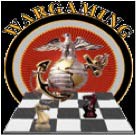
The USMC’s Log MOD-2007-2 War Game was held in Quantico in September 2007. The game was held over five days. Whereas the first game (October 2006) focused on participating in shaping the reform approach, this war game was dedicated to kicking the tires and test driving the concepts. Eighty-five professionals participated in the Wargame, most with significant recent combat experience in Iraq and Afghanistan.
The first game helped develop the reform approach. The second game confronted the approach with a range of real world problems and identified core challenges, which the approach will have to overcome to become viable.
The game was a remarkable effort to sort out the tensions in transitioning to a more effective approach to battlefield logistics support. Three core themes came up throughout the games. The first was the tension between the approaches which embedded logistics support on the battlefield and the nascent IT systems which can empower such an approach. The second is the tension between the current operations in Iraq, which are in place logistics for a “second land army,” and the real requirements for the USMC of expeditionary logistics for an engaged distributed force. The third is the tension between lessons learned from past operations and the needs for a sea-based force which the USMC sees as core to its expeditionary future. What logistics reforms fit the future, rather than the past? What realistic capabilities will be deployed with regard to IT? And how much trust can be put in the new system so that hoarding and stockpiling can be overcome as legacy logistics realities?
Simulation: a relatively new tool for USMC logisticians
War gaming and simulation are relatively new tools being used by the United States Marine Corps as a whole. According to U.S. Marine Corps Sergeant Donald Bohanner, the command has been working on their development since 1995 – when the Marine Corps Warfighting Lab (MCWL) was actually established -, but “the push for Marine Corps simulations occurred in 2001 with a research project initiated by the technology division at Training and Education Command to investigate technologies to create a Deployable Virtual Training Environment for Marines”[1]. The advantages over – or in complement to – live-fire training are financial, but can be measured in terms of time-saving, risks and preparedness. The Marine Corps Wargaming Division, based in Quantico, is in charge of the program and part of the MCWL.
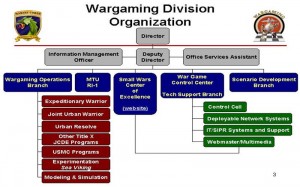
Game One, Present at the Creation
From October 30th to November 3rd 2006 USMC logistics professionals gathered for the first time to participate in the inaugural Log Mod war game. The main objective of the 2006 game was to first “define the roles, responsibilities and relationships of the various Logistics Operations Center (LOC) staffs” and “to generate a draft policy and doctrine”[2]. With the transformation of the traditional Force Service Support Group (FSSG) into the Marine Logistics Group (MLG)[3], LogMod has been seeking- and War Gaming has been one of the tools allowing to do so – “to establish habitual relationships and a single point of entry for requests between the supported and supporting commands within the MAGTF [Marine Air Ground Task Force ] to ensure tactical logistics functions are executed and fulfilled effectively”[4].
Initiated right after the reorganization of the MLG, the first game was aimed at examining the LOG C2 (logistics command and control) in order to define the missions of the various structures just created. It was to assess the responsibilities and resources necessary to implement the overall vision of what was referred to by a participant in this year’s war game as a “holistic approach to logistics”. The difficulty has been to shift from a decades-old vertical chain of command to a structure in which all the traditional functional directions – maintenance, transportation, supply, engineering, C2, medical/dental – are integrated within each CLB (Combat Logistics Battalion), which requires a complete overhaul at the regiment level. In the words of one of the officers in charge of Log Mod 2007-2, Major Vincent Applewhite, “the CLB structure was adopted to maintain a permanent logistics C2 structure built around a core transportation capability. The CLB maintains a habitual support relationship with an Infantry Regiment. Based on this standing structure, CLB, it can be rapidly “tasked organized” to meet mission requirements. The core CLB is approximately 330 Marines and may be augmented up to 800+”[5].
From the Force Service Support Group…
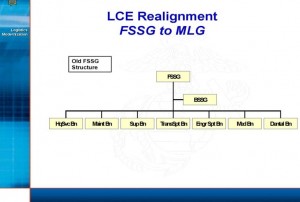
… To the Marine Logistics Group[6]
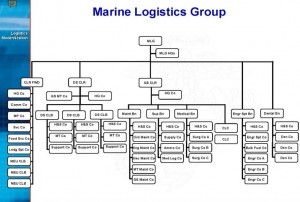
Game Two: Playing Out and Evaluating the Approach
The second war game, which occurred mid-September 2007, was also done in Quantico and implemented by the MCWL. There was broad participation by representatives of the Marine Corps (such as Marine Aviation), as well as of other services and agencies (such as GSA – General Services Administration – and Marine Corps Installations) and outside contractors supporting the program administratively (i.e. Booz Allen and Hamilton, CTC and EG&G).
Log Mod 2007-2 continued the process started during the first Log Mod game (described by a participant as a “wish list for officers”). The goal as described by one of the organizer, Mike Resnick, was to “make the changes across the Corps”, while fine-tuning the process down to the RCT (Regiment Combat Team) level in order to better provide support to the infantry[7].
According to the organizers:
“The purpose of Log Mod 07-2 is to examine logistics support request procedures and the roles, functions, and activities of the Logistics Combat Element and the supporting establishment while supporting a Ground Combat Element conducting maneuver in the MEF battlespace. Log Mod 07-2 will examine the feasibility and practicality of changes in capabilities, staffing, process and technology as recommended by: the Field Maintenance Capability Alignment (FMCA) workshops, MARCORLOGCOM SECREP management concept of operations, Realignment of Supply Spiral I process action teams, and the MAGTF Distribution Conference and policy.”[8]
Log Mod 2007 was designed to test a number of core reform initiativesin terms of their impact on the “affected units”. The players used the same matrix during the various game moves, and formed the basis of reaching conclusions about the challenges of implementing the reform.
Testing four key aspects of the Log Mod process
The game tested four key elements of the matrix in terms of the challenges facing the reform process. The first was the challenge of realigning the supply chain. The second was the realignment of maintenance and where maintenance would be best performed. The third was a key aspect of the realignment of supply, namely secondary repairs. There was especially spirited discussion on this point during the game. The final challenge was the logistics distribution throughout the MAGTF, or where optimally to organize the distribution network in terms of responsibilities.
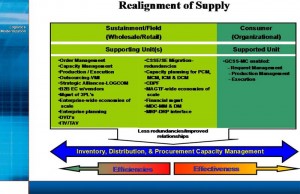
RoS (Realignment of Supply) Spiral I
Ros Spiral I is the first phase of the Realignment of Supply initiative and the first listed initiative on the matrix. The responsibility for order management is transferred from the supported unit to the supporting unit, while one supporting unit per MAGTF is to be in charge of both inventory and procurement. One focus of the game was to assess the feasibility of such a shift in responsibilities, as well as assessing the necessary resources to make it effective. Four “capabilities” were explored: inventory positioning; removal of order management functions from supported units; centralization of order fulfillment and capacity management (inventory, procurement) responsibilities in one supporting unit for each MAGTF; migration of inventory management and inventory warehousing functions for some classes of supplies.
RoM (Realignment of Maintenance)/FMCA (Field Maintenance Capability Alignment)
A key aspect of the new MCMP (Marine Corps Maintenance Policy) is the reduction from traditional five echelons of maintenance (EOM) three levels of maintenance (LOM): operator/crew, field and sustainment.
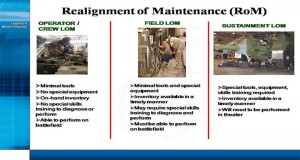
The players of the game assessed the impact of the RoM Field Maintenance Capability Alignment (FMCA) regarding the migration of the ground SECREP (Secondary Reparable) repair capability from the supported unit to the supporting unit or LCE (Logistics Combat Eleent).[9] Seven capacities were addressed in the matrix: migration of the capability for repair of ground common comm/elecSECREPs (line replaceable units) from the supported unit to the LCE; shared responsibilities for engineer Field LOM tasks between the LCE and and ground combat element (GCE), specifically component repair, evacuation and end item recovery/evacuation missions; realignment of all field LOM support repair tasks for AAV, LAV (light armored vehicles) and tank-unique systems within the GCE units; migration of all Field LOM component and parts replacement tasks for artillery equipment to GCE units; shared responsibilities for component repair, evacuation and end item recovery/evacuation missions between the LCE and GCE units; migration of selected maintenance support tasks such as annual small arms gauging tasks, replacement of small arms barrels and replacement of optics components and parts from the LCE to the organic unit; alignment of electro/optical repair special tools for Field LOM units with only 2nd EOM kits.
RoM / MARCORLOGMOD SecRep (Secondary Reparable) Management
SECREP is a process improvement effort under the RoM (realignment of supply) initiative and has been another central concept of operation around which the war game was designed. Here too the idea is to provide a single point of contact to integrate and improve the process of management of secondary reparables, as well as improving tracking and visibility of the assets. Four capacities were in this case examined carefully, as detailed in the matrix: implementation of recommended LOGCOM Concept of Support for SECREP management; MCLC (Marine Corps Logistics Command) ability to coordinate and track SECREP asset postures to support cross-leveling opportunities across the Marine Corps; MCLC ability to coordinate and track configuration of SECREP assets repaired within the MAGTF and rebuilt at Sustainment level maintenance activities; MCLC ability to coordinate and track evacuation of SECREPs from forward deployed locations.
SecRep Diagram 07
MAGTF DISTRO
With the MAGTF Distribution concept, a single distribution officer becomes the single point of contact to coordinate the whole distribution process, while having the authority to “task transportation assets throughout the MAGTF as the overall Distribution Capacity Manager”[10]. In this case, four capacities were also examined by the game: establish a distribution officer as the single point of contact to integrate, coordinate, and supervise distribution processes; MDDOC (MAGTF Deployment and Distribution Operations Center) authorized to oversee and task transportation assets across the MAGTF as the overall Distribution Capacity Manager (DCM); Configuration of the MDDOC and MMDC (MAGTF Materiel Distribution Center) tables of organization and equipment per the MDDP; MMDC conducts throughput operations.
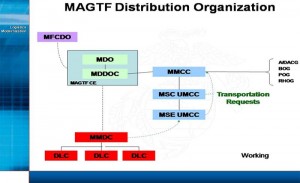
A seminar-style War Game
The LogMod 07-2 War Game Operations Order describes the conduct of the simulation as a “seminar-style War Game based on a single Marine Logistics Group (MLG) scenario designed to examine logistics support request procedures (…)”[11], as opposed to a “box game”. The game was to evaluate the “procedures, roles and functions rather than the players’ performance”. The players communicated via email (Email CPX game) and kept track of all their exchanges for further analysis at the end of each day (outbriefs).
The game was divided into five moves and based on a scenario called “Barbary Sword”: the goal of the operation was to free an allied country from a foreign invasion; in twelve days, the shift was from “MEF in the defense to MEF in the offense”, and included a sea-based logistics exercise. Stage 1 was “Assembly”; Stage 2 was “Movement to Attack Positions”; Stage 3 was “Defeat 1st Echelon”; Stage 4 was “Defeat 2nd Echelon”; and Stage 5 was “Restore the International Boundary”[12]. The players – divided in four cells – were to review the impact of each move on the major aspects of each initiative and draw conclusions about the feasibility of the reform at the end of the five day-war game. To do so, each organization (and for the final questionnaire, each single player) had in particular to answer the following question: “What were the impacts of the Log Mod Concepts on your organization’s ability to execute your mission in this move?” During each move, the players had to respond to new developments and deal with bottlenecks, or what was referred to as MESLs, for Master Scenario Events List. Overall, the game included seventy MSELs.
Who’s got the mission? Who’s got the asset?
Concretely, some of the questions raised and addressed during the game were:
- Where will maintenance be performed on the battlefield?
- Where will inventory be positioned on the battlefield?
- Where will distribution be performed on the battlefield?
- Where will MAGTF go for transportation?[13]
How does each segment affect each other? How would they be best integrated? How to bring resources to the theater in the most efficient way? Is more maintenance needed? More equipment? More personnel? More capacity to support it? Who can fix the fastest? How to act quickly? What are the consequences? All these challengeswere raised very early in the game to make sure that potential gaps in the policies being drafted were to be addressed[14].
The war game allowed to assess the pros and cons of each Log Mod initiative and generated multiple debates and recommendations to address some the issues at stake. Here is an attempt to sum up some of the conclusions made at the end of these five days of discussions for each initiative.
RoM/FMCA
In the case of maintenance – which used to take place at the rear -, the question posed during these five days of simulation was to find out at which level it would be best performed. New recommendations were integrated in this war game and one of the conclusions was that “maintenance can be embedded at the CLB level”.
RoS: centralized order management
The same question was posed as far as supply was concerned: should inventories be spread across the battlefield or is it better to have an “avenue to go back to”. In this case, the IT enablers allowing the process were not yet fully available. The trend is to “move away from stockpiling to positioning.” To do so will require decentralization in order management across the board with centralization at the CLB level and in the execution of the orders. Among the conclusions made the last day, the risk of the CLB becoming a bottleneck was stressed. The physical burden of warehousing and the loss of flexibility it implies was highlighted.
A recommendation made by one of the cells was that the MLG should be the center of excellence for centralized order management. However, Log Mod demonstrated the feasibility of reducing the RCT log footprint, as well as eliminating double orders at the RCT level.
MAGTF Distro
Log Mod War Game 07-2 was also an opportunity to examine the distribution pipelines and to determine better ways to perform this function. The goal is to bring “just the right stuff”, but no more, so the force remains “light, lean and fast”. From this point of view, the Marines have an advantage over the Army in the sense that they never were able to carry a lot with them (just because they would often be sea-based) and the sense among the officials in charge of the War Game was that “if the Marines cannot do that, nobody does”. One of the major changes – besides, and parallel to, the integration of various services within the MAGTF – is the existence of liaison officers embedded in units and able to go back and forth the pipeline. This is a major advantage in getting rid of the “iron mountain” mentality. At the end of the war game, there was a consensus that the MAGTF Distro process did succeed in adapting to a decentralized battlefield and in increasing asset visibility, but that the augmentation in requirements was not matched by an augmentation in personnel. A recommendation was made about the potential use of reserve forces.
SecRep Management
The new SecRep management process was perceived by participants as improving the accountability factor, but that there was an increase in cost and footprint, as well as increased demand. This could however be solved, according to a participant, via a more tailored approach of SecRep allowances. The need for standardization was also stressed. The shift in the control of assets was discussed in terms of pros and cons: the advantages were that there was a “continuity of Ops when the MEF was deployed” and that it provided a “stable training platform for Active duty personnel”; on the other hand, the MEF was losing control of assets, budget and process[15].
Another question raised during some of the final outbriefs was the ability to test a piece of equipment just fixed at the battalion level. The answer was that more than often it is fixed without having to be tested (either it starts again right again or it does not), but that testing can be performed as long as the battalion is not on the move. One of the participants recast this question as follows: would it make sense to develop new equipment which would precisely allow a repair done on the move?
The Key Challenges to Be Addressed
Improving asset visibility
A recurrent theme during the five days of war gaming in Quantico was summed up by one of the participants with these two very simple core-questions: “Who’s got the mission? Who’s got the asset?” The most frequent complaint has been to first clarify who was doing what (especially in terms of prioritization of assets), and secondly how reliable the new process was. Indeed, the questions of trust and accountability are at the very basis of the success of logistics reform as a whole. Past experiences have often been rooted in the fact that whoever owned some assets would tend to hold on to them by fear of not being properly supplied on time. An interesting discussion took place during one of the outbrief sessions about whether or not to institutionalize a practice developed in Iraq, which has been consisting in carrying a small percentage of equipment in excess capacity (about 5%; 10% in the case of trucks). The balance between autonomy (with the extra-weight involved) and trust in the system is obviously a difficult one to achieve and one the Marines have been struggling with. In the case of this exercise and according to one of the players, “based upon lessons learned during OIF, forward in-store capacity was included during the planning stages of the operation to provide a ready source of combat replacement equipment”. This concept of “forward in-store capacity” is resembles mobile pre-positioning and is intended to facilitate force replenishment.
The problem lies however in the fact that it is not so maneuverable (back to the footprint issue) and therefore needs to be calibrated in regard with future sustainment requirements. That is indeed the main change compared to the past, when pre-positioned logistics were in place. Another question raised was the fact that “ if lots of people were to carry SecReps, how do you get then back to be fixed and then sent back?” The current situation is that the repair tends to be done on the battlefield and the advantage of a small excess ad hoc capacity is precisely to be able “to fix on-site as opposed to fill out the pipe of supply”. The consensus is that it is better to repair as opposed to replace, especially given the problem of transportation likely to occur in wartime (e.g. “no truck to be found in Bagdad”). However, if this may be true for trucks and tanks, the “center for excellence to fix SecRep” is not necessarily at the battalion level. This raises issues not only in terms of transportation, but also as far as how much staff one needs at each level and what kind of qualifications are required.
Adapting training
Marines now involved in expeditionary warfare need to be more flexible, more autonomous and more qualified. The Marines have an advantage over other services as its training traditionally has been less specialized and strived to maintain the same level of quality across the board. As Major Applewhite pointed out, “the Marine Corps’ policy of “quality spread” to assign officers across all occupational fields thus ensuring and equal distribution of high caliber officers in the MAGTF’s Aviation, Ground, and Logistics Combat Elements. Moreover, all Marine Officers are MAGTF Officers trained to understand all elements of the MAGTF, including their employment and support requirements. The resulting synergy combined with our expeditionary culture produces Marine Officers capable excelling across the full logistics spectrum.”
But for the logistics community, the current modernization pushes the process even further (as one participant put it: “training is cross-leveled across the enterprise”). The purpose of the Log Mod 2007-2 was precisely to identify which additional skills would be necessary to achieve better results, especially at the regiment level, while assessing “the complexities associated with task organized logistics in direct support of Regimental and Battalion sized maneuver forces and challenge of developing and maintaining the logistics skill sets needed to manage and lead those logistics organizations”[16]. The need to “re-train in a deployed environment” was stressed: one of the major difficulties encountered is indeed for the logisticians to adapt “on the fly” to mission-oriented assignments, hence training needs to emphasize flexibility and responsiveness. One participant noted that the good news was that the “training was actually rather easy as long as one can do it at the unit level”.
Staying focused on Expeditionary warfare
Dealing with conflicting requirements
One of the major challenges for the US Marine Corps is to remain focused on its primary mission, i.e. expeditionary warfare as the war in Iraq has been pulling it in the exact opposite direction. The Marine footprint in Iraq has been much heavier and longer-term than initially planned. The risks of drifting towards a “second land army” posture has been stressed by the USMC Commandant himself who recently proposed to deploy the USMC as the lead US force in Afghanistan, leaving Iraq to the Army as the lead force.. The USMC leadership is deeply concerned with losing their expeditionary focus. This is true in terms of training (neglecting some aspects such as sea-based operations for instance), equipment and logistics structure and organization. What appeared clearly during this war game is that the dilemma for the logistician is to constantly base his/her decision on a “balance between the best solution and the better one”[17].
Operating in an increasingly joint environment: “keeping the MAGTF prospective”
More integration, more jointnessare required in the new battlefield environment. This war game demonstrated this at at least three levels:
- Within the MAGTF between the RCTs and the CLBs, the relationships worked well, but the connections with the logisticians in charge of repair needed to be developed further;
- Within the MAGTF between the ground and the aviation: as BGeneralReist pointed out, MAGTFDistro solved many problems, because the Navy and the USMC work together. This war game was including Aviation and the good news is that the procedures such as SecRep were done in a very similar way and very efficiently. This was considered an extra step achieved towards better MAGTF integration;
- Within the MAGTF between the operational and the logisticians: one of the conclusions made the last day was indeed the fact that more discussion was needed “between the MEF and the Log Mod folks”.
Bridging technological gaps or transitions
A key challenge facing logistics reform is the disjunction between new approaches and shifts of authority and the fielding of the IT technology, which empowers the transition. The whole concept underlying Log Mod relies on a new C2 architecture (which should be available within a two-year framework): “Technological enhancement, spearheaded by the Global Combat Support System Marine Corps that provides a single program and point of entry to access critical logistics data, will have the most impact on logistics modernization initiatives. Combined with state-of-the-art command and control systems with increased bandwith, Marines across the battlefield will benefit from real-time logistics status updates”[18].
During the game, the participants engaged in observing an exercise off site where the new Oracle system was being tested. Reactions were solicited from the game participants concerning what they saw and would like to see in the IT reform effort, notably with regard to metrics.
Conclusion: The War Game and the Challenge of Reform
If many Marines concluded that they were not “ready for prime time yet”, Log Mod 2007-2 did help however to identify the potential gaps in the system and “choke points in the Log Order of Battle”, which means that, from this point of view, the goal of the exercise had been attained.
One of the primary advantages of logistics War Gaming has been, from the point of view of many of the players involved, to bring together a large group of logistics professionals, who never had a chance till last year to meet in person and work directly together. Some institutional walls are hence starting to vanish, as the structures are being collapsed into more functional entities. Indeed, in his introductory remarks, the officer in charge of the event, Brigadier General David G. Reist, strongly emphasized the importance of teamwork and how such an exercise contributed to do so by bringing multiple perspectives to the table: “We are all looking at the same Rubik’s cube: we are just looking at different sides of it.”
War Gaming is also the only process allowing to put together not only the elements of the restructuring of the Marine logistic community (and maybe in the future, of the logistic community as a whole, i.e. Army included), but also the lessons learned from the current operations in both Afghanistan and Iraq. The level of combat experience among participants was indeed quite impressive and brought a sense of urgency in the way issues were addressed and solutions proposed. One of the recommendations made at the end of the exercise was to go even further next time by maybe increasing the links with the operational side and by moving from a seminar-style game to a “game with screen”[19].
If for some of the participants, the overall conceptual picture is still in flux, LogMod 2007-2 was unanimously acknowledged as a step in the right direction and helped identify the difficulties and challenges ahead. By bringing a large group of Marine’s together with recent combat experience, the right focus was evident throughout the game: “where do we bring Log Mod to support the needs on the battlefield?”
An earlier version of this article was published in Military Logistics International (November/December 2007) and written by Murielle Delaporte and Robbin Laird.
[1] The Marines Corps has been using as a result games such as Virtual Battlefield System One and Close Combat for training purpose. See: U.S. Marine Corps Sgt. Donald Bohanner, “Simulations Prepare Marine Corps for War”, Department of Defense Transformation, 2 December 2004.
[2] See: First LogMod Wargame conducted at Quantico, LogMod Ledger, November 2006, p.1 (available at logmod.hqmc.usmc.mil or at http://www.wargaming.quantico.usmc.mil/Documents/Press/Log%20Mod%20newsletter.pdf).
[3] An MLG is typically composed of 8,000 Marines and includes – “for support in Garrison or deployed” – 116 Refuelers, 300 Medium Lift Vehicles (MTVRs), 28 Rough Terrain Cargo Handlers, 120 Fork Lifts, 60 Mobile Cranes, 75 Maintenance shelters, 34 Bull dozers, 40 Road Graders, 80 Dump Trucks, and 82 ROWPU. (Source: Marine Logistics Group (MLG) Reorganization, briefing slides, Logistics Modernization.)
[4] LtCol. Manning, Deputy Director, LogMod Transition Task Force, as quoted in: First LogMod…, ibid, p.1.
[5] Major Vincent Applewhite functioned as the Deputy Director/Controller of the game. He is also the representative of the game sponsor (i.e. DC, I&L (LP).
[6] Marine Logistics Group (MLG) Reorganization,ibid.
[7] Interview with Mike Resnick and Major Vince Applewhite, Quantico, September 19th, 2007.
[8] Logistics Modernization Initiative War game 2007-2 (LOG MOD 07-2) Information Paper, USMC, June 2007.
[9] Realignment of Maintenance (ROM)/Field Maintenance Capability Alignment (FMCA), USMC, game “read ahead”.
[10] Marine Air-Ground Task Force (MAGTF) Distribution, USMC, game “read ahead”.
[11] Logistics Modernization 2007-2 War Game Operations Order, game “read ahead”, 7 September 2007.
[12] LogMod War Game O7-2, Executive Outbrief, 20 september 2007.
[13] Marine Logistics Group (MLG) Reorganization, ibid.
[14] Interview with Major Applewhite and Mike Resnick, ibid.
[15] SECREP Management, Cell A brief, September 2007.
[16] Major Vincent Applewhite, ibid.
[17] Major Applewhite, ibid.
[18] Lieutenant-Colonel Darryl Barnes, Marine Logistics … 2015 Style, Proceedings, November 2006, p.56.
[19] War Game Outbriefs, USMC, Septembre 21st, 2007: “Cell A” concluded in its LogMod Initiative assessment that there is a “Need to utilize tools available to conduct wargaming (SIM centers; CLC2S, BCS3)”.
———-
***Posted September 5th, 2009

